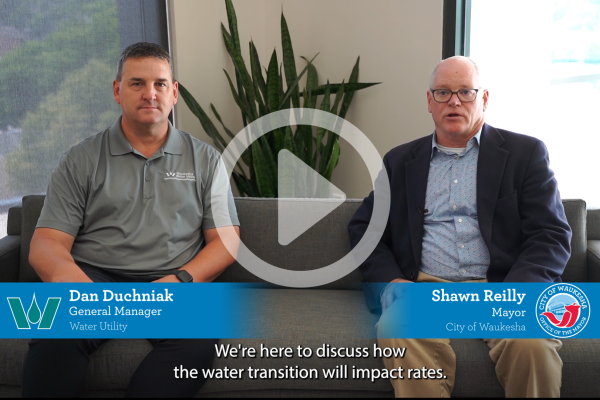Water Transition
After years of scientific analysis, community input and regional cooperation, the Great Water Alliance program has entered its final year, on time and on budget. We are about to enter the Transition Phase, which will include testing to ensure all pipelines and pumping stations are working properly before Waukesha switches from groundwater to its new water supply on October 9th.
Water Transition Open House Presentation
Dan Duchniak, General Manager of the Waukesha Water Utility, shares information about the transition to Lake Michigan water and what Waukesha residents should expect during and after the transition period.
Why new water?
The City of Waukesha needs a long-term, sustainable alternative to its existing water supply. The City’s primary source of drinking water, the deep aquifer, has become depleted, resulting in elevated levels of naturally occurring radium and other contaminants.
On June 21, 2016, the Great Lakes governors unanimously approved the City of Waukesha’s request to source water from Lake Michigan, finding that we have no reasonable alternative for our water supply. And, at the end of 2017, an agreement was reached for Milwaukee Water Works to provide Lake Michigan water supply to the Waukesha Water Utility. The cost of water from Milwaukee — which supplies water to more than 860,000 people in 16 area communities — will be substantially lower than from other potential suppliers.
The Transition Plan
On October 9th, Waukesha will transition its water supply to treated Lake Michigan water supplied by the City of Milwaukee. While you might notice temporary changes to the water supply, the Waukesha Water Utility has undergone extensive studies to minimize discoloration or other water quality issues during the transition.

This map shows how the new water supply will spread throughout the Waukesha distribution system.
Frequently Answered Questions
For many years, water in Waukesha has been supplied through multiple wells located throughout the city. After the transition on October 9th, treated Lake Michigan water will be supplied by the City of Milwaukee to Waukesha’s water distribution system. Pump stations, storage reservoirs and other facilities will help deliver Lake Michigan water (currently about 6 million gallons a day, on average) to the Waukesha Water Utility (WWU) distribution system, achieving Waukesha’s long-term vision of ensuring a reliable supply for generations to come.
Waukesha has undertaken extensive studies to minimize temporary discolored water or other water quality issues during the transition to a new water supply. This includes testing samples of Waukesha water pipes with Milwaukee water to check for any reaction to the different water chemistry. The studies were carefully coordinated with state and federal regulators as well as other water quality experts and found no long-term adverse impacts of the water transition.
More than a dozen area communities have successfully switched from groundwater to Milwaukee water without water quality problems. As part of Waukesha’s ongoing commitment to ensuring safe, reliable water, Waukesha Water Utility will also continue to monitor the water quality at the Booster Pumping Station and within the distribution system to address any issues that may arise during or after the transition.
As our experts work to introduce a new and reliable water supply to over 300 miles of water pipelines in Waukesha, you may notice temporary changes, including a rusty color, or changes in the taste or smell. These changes are temporary. Although this water will meet regulatory standards, we encourage you to run water through your water pipes to clear up these aesthetic issues before consuming it. See more on flushing out your pipes below.
Once the transition has been completed, customers in the areas south and southeast of the Fox River will enjoy slightly higher water pressures due to the addition of the new water tower. In other areas, there should be no impacts on pressure for normal usage after the transition.
Lake Michigan water is at least 60% softer than groundwater, which will be a permanent benefit of the new water supply. For more information, see our FAQ about water softeners below.
One difference with the new water supply is a change in the disinfection process from chlorine (used by Waukesha) to chloramines (used by Milwaukee). Both are commonly used to ensure public health protection and the change should be unnoticeable. However, the switch to chloramine may affect some health treatments, so you may wish to consult your health care provider (see information on dialysis below). Owners of aquariums or fishponds should also consult local pet stores about required changes in water treatment (see below).
Waukesha is committed to keeping community members and businesses up to date as the transition date approaches. We have been in touch with many businesses as part of the water transition planning process in case they have special water supply requirements.
Businesses that treat their water for processes or products should consult water quality and treatment professionals to assist with making adjustments, if needed. Also, like residential customers, businesses should be aware that temporary discoloration could occur for a short period during the transition.
If you have questions about your own business needs or would like information about water chemistry, please visit our contact us page or call us (262) 521-5272 during the transition.
What type of special precautions do kidney dialysis patients have to take with the water transition?
Chloramines are used to treat Lake Michigan water from Milwaukee. Like chlorine, which has been used to treat Waukesha’s groundwater, the disinfectant must be removed from the water before it can be used in kidney dialysis machines. While GWA representatives continue to provide water transition updates to medical facilities, kidney dialysis patients should contact their physician or local kidney dialysis center before the water transition begins for guidance on modifications to home dialysis machines and procedures. Medical centers that perform dialysis are responsible for and familiar with removing chloramines from the water that enters the dialysis machines.
While disinfection is essential and required to protect public health, chloramines, like the chlorine used for Waukesha’s groundwater, can be harmful to pet fish, reptiles and amphibians. Area pet stores should be familiar with precautions (inexpensive water treatment or specified carbon filters) to remove chloramines in the new water supply from water for aquariums, reptiles and amphibians. You can tell them that your new water supply will be from the Milwaukee Water Works, which is used by many area communities. Be sure to contact a pet supply store before the October 9th water supply transition for information.
Yes. Our experts are planning for a smooth water transition, including minimizing temporary impacts to customers. However, as with our annual pipe flushing in your neighborhood, your water can be temporarily colored as the normal buildup of minerals in the pipes is washed off. You may experience a similar temporary impact on your water during the water supply transition, as groundwater is flushed out and new water is introduced. In some neighborhoods, water may travel in a new direction, potentially causing temporarily discolored water.
The impacts in some areas may be greater than others or occur at different times. Many customers may not notice a change at all. Water could turn yellow, orange or brown for a short time from normal mineral buildup or sediment in pipes.
Discolored water is generally associated with iron in pipes and while aesthetically unappealing, according to the U.S. Environmental Protection Agency (EPA), iron does not pose an immediate human health issue.
If you experience discolored water:
- Flush the water pipes in your house with cold water.
- Delay activities such as washing clothes until the color goes away. If you do end up with color in your clothes, do not put them in the dryer because that can set the stain. You can use products like Red-B-Gone or Iron Out. You can get rust removers at local hardware stores, online or in small quantities from the Waukesha Water Utility (while supplies last).
- Avoid using the water and delay making ice until clear water once again flows from your pipes.
That is recommended. The normal buildup of sediment and minerals could break off from the inside of the water pipes during the transition, which can temporarily cause discolored water. This is similar to what happens during our annual flushing program.
Those minerals and sediment can also collect in water filters, causing them to reach their useful life prematurely. You can prevent that by removing or bypassing your in-home water filtration systems – like the ones used with some refrigerator water dispensers or attached to kitchen faucets – before the start of the transition. You should also bypass any reverse osmosis (RO) system, if you have one. You can resume using filters again in a normal manner after the transition, or after you’ve flushed your system (see FAQ below) and your water runs clear.
You should also bypass your water softener during the transition for the same reasons. See additional information on water softeners in FAQs further below.
Improving discolored water conditions is often as simple as flushing your water pipes to remove the accumulation of sediment. This optional procedure is outlined in the following steps.
Step 1: Remove the screens (called aerators) from the ends of the indoor faucets and run all of the cold-water faucets wide-open and simultaneously for three to five minutes.
Step 2: Flush the toilets two or three times each while the faucets are running. Running all the cold-water faucets and toilets simultaneously generates a large flow of water through the pipes and will generally dislodge any buildup of organic material that is causing the taste and odor problem sediment. Removing the aerators before flushing the plumbing will help prevent them from clogging.
Step 3: After three to five minutes of flushing, turn off the water faucets, clean the aerators, and reinstall the aerators on the ends of the faucets.
Flushing your water pipes is not expensive. While we all want to be wise with our water use, flushing four faucets and two bathtubs, for example, would use only 120 gallons at a cost of less than one dollar.
During the transition, as groundwater and Lake Michigan water supplies mix together, you could notice a temporary chlorine-like taste or smell more than usual. This is associated with the process to ensure a smooth transition from one supply to the other and should only occur for a day or two, if it is noticeable at all. The water is safe to drink and meets regulatory standards, although you may wish to flush your water pipes (see above) to address those types of issues. If you notice an unusual taste, smell or color for more than three days, please contact the Waukesha Water Utility at (262) 521-5272.
Once the transition is completed, you might notice a slight change in the taste because Lake Michigan water has less mineral content than our current groundwater. This new water supply, from the Milwaukee Water Works, is currently used and enjoyed by more than 860,000 people in 16 communities throughout our area.
Waukesha will switch from its existing groundwater supply to Lake Michigan water on October 9th for all of its water customers, including the small numbers outside of the city who were approved for service through the city’s Great Lakes Compact Application. The entire transition to 100% Lake Michigan water could take as long as one month, as it enters the supply system on the east side of Waukesha and travels through the city. However, any impacts at individual locations will likely only be noticeable for a week or less. The City has undertaken extensive analyses to ensure the introduction of this new supply will be as simple as possible for customers and will meet all water quality regulations throughout the transition process.
Yes. Waukesha will be switching to 100% Lake Michigan water. Lake water will only be mixed with our existing water supply during the transition period, which could last up to one month in some locations. After the transition, the water will be completely lake water. Blending of groundwater and lake water is not allowed under the approval under the Great Lakes Compact. The Waukesha Water Utility will continue to maintain some of its deep groundwater wells, but only for use in an emergency, as is allowed under the Great Lakes Compact and under our approvals.
Waukesha’s existing groundwater supply — a deep aquifer — is depleted, due in part to a natural formation (a thick layer of shale rock) that restricts rain and snowmelt from naturally percolating through the ground and recharging it. As water levels have decreased, levels of naturally occurring contaminants such as radium have increased. Long-term use of the aquifer is not sustainable. Continuing to pump groundwater until exhaustion would require expensive treatment to remove contaminants and be environmentally irresponsible.
Waukesha’s secondary water source is shallow groundwater wells. Adding new shallow groundwater wells would have permanent adverse environmental impacts on valued brooks and streams, as well as nearby wetland habitats in environmentally sensitive areas.
Currently, state regulators allow Waukesha Water Utility to operate while meeting radium standards on a flow-weighted average but, moving forward, we are obligated to come into compliance with the standards at all times. The switch to a new water supply allows us to do that.
The unanimous approval by the Great Lakes states under the Great Lakes Compact found that none of Waukesha’s alternatives to Great Lakes water are “reliable sources for a long-term, dependable, and sustainable public water supply.”
In fall of 2023 (likely October), your total water bill is expected to increase 14.7%. Another 15.4% increase is expected in the Fall of 2024.
Your water bill has three parts to it — water supply, return flow and wastewater. The water supply portion is increasing significantly in those years as the bulk of the costs of building the substantial infrastructure needed for the new Lake Michigan water supply are added to customer bills.
In July 2023, the Waukesha Water Utility sent customers a legally required notice that the Wisconsin Public Service Commission was considering a 42% increase in the fall of 2023 and a 35% increase in the fall of 2024 (or 91% total over the two years). That led many customers to believe their entire bill would increase by those amounts. In fact, only the water supply portion, which currently makes up less than half your bill, will increase by those amounts.
The average residential customer (using an average of 4,000 gallons of water per month) would have an increase of $15 (from $102 to $117 per month) in the fall of 2023 and $18 (to $135 per month) in the fall of 2024 in their total water bills. These rate estimates are in line with water rate projections made at the start of the project in 2016 and in a 2018 mailing to city residents about total water costs.
For more details about water rates and other aspects of the new water supply project, go to https://greatwateralliance.com/about/myth-vs-fact-faq/.
Waukesha is committed to keeping community members and customers up to date before, during and after the transition. We will keep customers informed about transition details via social media, water bills stuffers and other means, as well as on this Great Water Alliance website. You can also sign up to receive updates. You can contact us with additional questions at (262) 521-5272. You can also follow the Great Water Alliance on Facebook and Twitter.
Milwaukee is the largest supplier of fresh water in Wisconsin. Almost half the residents of southeast Wisconsin drink water from Milwaukee. Waukesha will join nearly 900,000 consumers in 16 communities that are already served by the Milwaukee Water Works. More than a dozen communities have switched from groundwater to Milwaukee water from Lake Michigan. Delivery of Milwaukee water to Waukesha has been a great display of regional cooperation throughout the entire area.
Delivery of high-quality, reliable water to customers is and will continue to be the city’s top water service priority. Waukesha’s water will be safe to drink and meet state and federal regulations during the switch to a new water supply. The transition process has been approved by regulators. We certainly understand that discoloration, taste and odor can be aesthetically unappealing, so consider running your water until it runs clear before use. It is a personal choice whether to use a filter or bottled water during this temporary transition period.
Any person or business with special water requirements should consult their water treatment specialist or physician to address individual needs. Special populations, such as people with weak immune systems (e.g., transplant patients or people with AIDS) should check with their physicians before consuming any type of drinking water, including bottled water.
It’s your choice. Whether or not to use a softener is a matter of personal preference. Some users will choose to remove their softeners after Waukesha switches from groundwater to Lake Michigan water from Milwaukee on October 9th. Lake Michigan water will be at least 60% softer than our current water supply.
It has been found that many water customers object to hardness of more than 9 grains per gallon. Waukesha’s current groundwater supply averages around 21 grains per gallon. Therefore, most of Waukesha’s customers currently use water softeners.
Waukesha will transition to 100% Lake Michigan water from Milwaukee on October 9th. Water from the lake, at 8 grains, is below the level of hardness that many people would object to. Most users of Milwaukee water — including those who have switched from groundwater — choose not to use water softeners.
If you are considering getting a new softener, you may want to wait until after the switch to Lake Michigan water to determine your satisfaction with unsoftened water before investing in a new softener. If you currently have a water softener, we recommend that you bypass your water softener during the transition and for a month or two once the transition is complete to determine your satisfaction with unsoftened water. You may also want to ask friends in the 16 communities that use Milwaukee water about their experience with softening.
Like many other communities, Waukesha must meet federal chloride standards for wastewater. Softener salt is the largest source of chlorides in the wastewater discharges by the Clean Water Plant. Chlorides are harmful to fish and other aquatic life in rivers and other bodies of water.
We need to reduce chloride levels or else wastewater costs for all users will go up significantly. There is no cost-effective way to remove softener salt at the Clean Water Plant, so we need to reduce the level of use at homes and businesses.
If you choose to continue using your water softener after the transition to 100% Lake Michigan water, you must have it optimized. That means having an approved optimizer adjust settings for hardness, salt dosage and reserve capacity. Optimizing your softener, including adjusting for the hardness level of Lake Michigan water, can achieve as much as 80% of the salt reduction that would be realized by removing your softener. That should save you money without a noticeable change in water quality.
For most users, the deadline for optimizing their softeners will be Jan. 1, 2025, and no action is required at this time. However, high-volume water users (more than 80,000 gallons per year) must optimize by Sept. 1, 2023, or as soon as can be scheduled, in order for us to demonstrate progress on meeting the chloride standards. High-volume users have already received letters from the city explaining the requirements. If the city does not show progress on meeting the standard, it may be forced into other options, including eliminating the choice on whether or not to keep your water softener.
If your softener is a time-clock unit, it must still be optimized. If you wish to continue softening after the switch to Lake Michigan water, we encourage you to replace your time-clock softener because it uses much more salt than modern softeners.
You can learn more about the water softener optimization program and find a list of approved optimizers at the city’s website here. Or call the Waukesha Clean Water Plant at (262) 524-3628 for additional information.
No. Milwaukee’s water treatment facilities are among the most advanced in the country. The Water Works has technology and redundancies to ensure that Waukesha will have a constant flow of reliable, high-quality water for decades to come.
Although some people remember the Cryptosporidium outbreak, it is important to remember that it was almost 30 years ago. Milwaukee’s response set a national standard for public health protection. It addressed the issue with advanced technology, including ozone disinfection and upgraded filtration, as well as continuous monitoring. It also moved its intake pipe farther and deeper into Lake Michigan.
For an in-depth look at Milwaukee’s advanced levels of water treatment, see this WTMJ-TV segment.
No. Sewer overflows have been significantly reduced in Milwaukee, but those that do occur are not a threat to drinking water from the Milwaukee Water Works. Milwaukee’s water intake pipe is far from shore and deep in Lake Michigan. In addition, the Milwaukee Water Works treats the water with ozone disinfection, biologically active filtration, and chloramine disinfection. It is also nationally recognized as a leader for its comprehensive water quality monitoring program.
Waukesha will continue to rely on its own Clean Water Plant to apply advanced levels of treatment to its wastewater before returning it to the Lake Michigan basin. Our wastewater will not go to the Milwaukee Metropolitan Sewerage District and will not be affected by overflows or backups in that system.
There are no city-owned lead pipes in the Waukesha water system or risk of lead in the pipes bringing water from Milwaukee to Waukesha. Milwaukee uses an effective lead corrosion inhibitor to address the potential issues with in-home plumbing that can contain lead, like copper pipe solders or brass fixtures in older (pre-1980s) homes. However, if you have concerns about the plumbing in your home, you may want to have the water inside your home tested. For more information, see https://www.epa.gov/ground-water-and-drinking-water/basic-information-about-lead-drinking-water.
Clear as Water Series
Our “Clear as Water” video series was designed to provide you with answers on Waukesha’s transition to Great Lakes water. Join Dan Duchniak from the Waukesha Water Utility and other Waukesha water experts as they provide clarity around the water transition and discuss topics that will be important for Waukesha businesses and residents to know.
Resident
Resources
Resources


